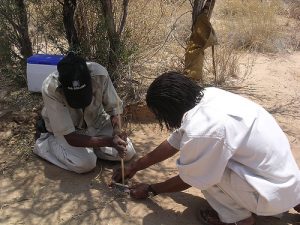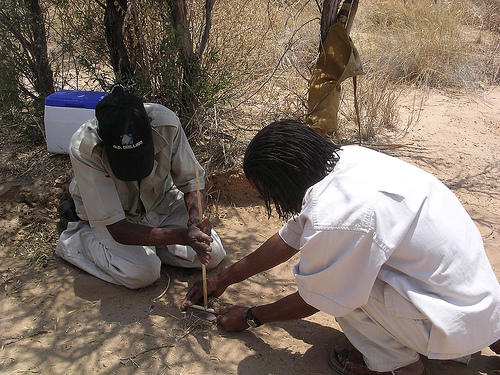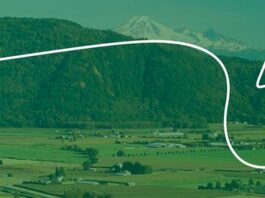By Nick Ubels (Online Editor) – Email
 What is the connection between language and culture, or one’s homeland and a sense of belonging?
What is the connection between language and culture, or one’s homeland and a sense of belonging?
Noam Chomsky once said that “language embodies the world view of a culture.”
Before they reached a milestone land claim settlement with the South African government in 1999, the dispossessed =Khomani San, or Bushman people, were regarded by many as invisible and faced the complete loss of their traditional language.
“The people I was working with [had] completely disappeared. They were obliterated by waves of immigration reaching back some hundreds and even thousands of years,” said Hugh Brody, an anthropologist, author, filmmaker, and Canada Research Chair in Aboriginal Studies at UFV. Brody discussed his 15 years of work with the South African San Institute and presented a short documentary film on the same subject on February 15.
According to the film, all Bushman communities of South Africa had been destroyed by 1950.
Brody was asked to spearhead the research portion of a land claim for the Kruipers, a =Khomani San family who had been expelled from their home in Kalahari Frontier National Park in the 1970’s.
“The job at hand was to build the story, to set in place a research project that would show who these people were and where they came from,” said Brody. “I was lucky enough to be asked to design this research.”
Brody and his team of researchers needed to prove to the authorities that the Kruipers were “real Bushmen.” This proved difficult, because the family did not speak the traditional Bushman language. Instead, they spoke Khoekhoegowab, the language of a sheep-herding group that had come into the area 1500 years ago.
“The argument used against them was one often used against aboriginal people,” Brody explained. “They weren’t considered ‘pure’ enough.”
In 1974, linguist Anthony Traill had declared the last Bushman language of South Africa to be extinct. This all changed in 1997 when Brody and his team made contact with Elsie Vaalbooi, a nearly 100-year-old woman living in a tiny lean-to in Rietfontein who said she spoke “die Boesmantaal,” Afrikaans for the Bushman language.
“[Traill] came and visited Elsie Vaalbooi in her lean-to and he had with him a tape that had been recorded in 1935 in which people are speaking the Bushman language of the Southern Kalahari,” said Brody. “He played this tape to Elsie Vaalbooi and she could translate every word of it. It turned out to be the very language she spoke and that language was called N|u.”
While most European languages have between 30 and 35 sounds, N|u includes 135 distinct sounds out of a possible 160 sounds that make up every known human language.
“Not only had we found a speaker of this language,” said Brody, “but [it was] of one of the most sophisticated and fascinating languages in the world.”
Unwilling to accept that Vaalbooi was the only remaining speaker of N|u, Brody and his team sought out other speakers in the surrounding area. They eventually found 22 people fluent in N|u and hundreds of other =Khomani San people who had been dispossessed.
“This was a disparate, scattered population who converged around a land claim and forged a kind of identity and political purpose… It was not an easy thing to do, but it was something that was done with tremendous strength and determination.”
According to Brody, the research team had begun to prepare for a hearing, but expected it to be a long claim process because it was coming from an isolated part of the country and was hotly contested by the Parks Department.
“We thought, ‘This is going to be a long difficult job,’” he said. “Then suddenly, one day… my colleague rang and it was Nelson Mandela’s office… They heard about this claim and they wanted it to go through.”
“We discovered they had realised the incredibly iconic value to this claim. These were the original victims of racism in South Africa. And Mandela’s government was determined to create a new justice.”
It was shortly after their claim was fast-tracked in March 1999 that incumbent South African President Thabo Mbek met with Dawid Kruipers and reached an out-of-court settlement that provided the =Khomani San with 65000 hectares plus extensive land use rights to the Kalahari National Park.
“It’s a result of our project that people were connected again… Even within quite close families and very much across extended family and kin lines,” Brody said.
Although he views the project as a success, Brody acknowledged that bringing such a far-reaching group of disconnected people together in a single community was not without its problems.
“It went through fast, and it perhaps went through too fast… The fact was the land claim unleashed intense difficulties. I had to raise money to put in place conflict resolution services. We use a lot of the film and a lot of the oral history recording as a way of creating awareness of one another and understanding.”
Brody recalled what one =Khomani San woman had told him: “We will have won when every South African child learns about us at school.”
“To become known was what they were asking for,” he said. “And that’s when I understood my mandate.”
By 2008, Brody’s team found themselves with over 125 hours of footage, 1000 archive photographs, and countless maps and other documentation going back to the beginning of their research in 1996.
“We’ve got all of this material,” he said, “So how do we fulfill our mandate? How do we make it all available? And that’s the web.”
Brody’s team set up a partnership with a research centre at the University of Witwatersrand in South Africa which will hold the =Khomani San Archive Project and digitize it. Researchers and students will eventually be able to access it through web portals across the globe, and Brody is hopeful that UFV will someday keep a full copy of its own.
“We have everything transcribed… and translated into English,” said Brody. “Theoretically, you should be able to click on the piece of transcript and then bring up that piece of film. So that’s the vision that we’re working on.”




